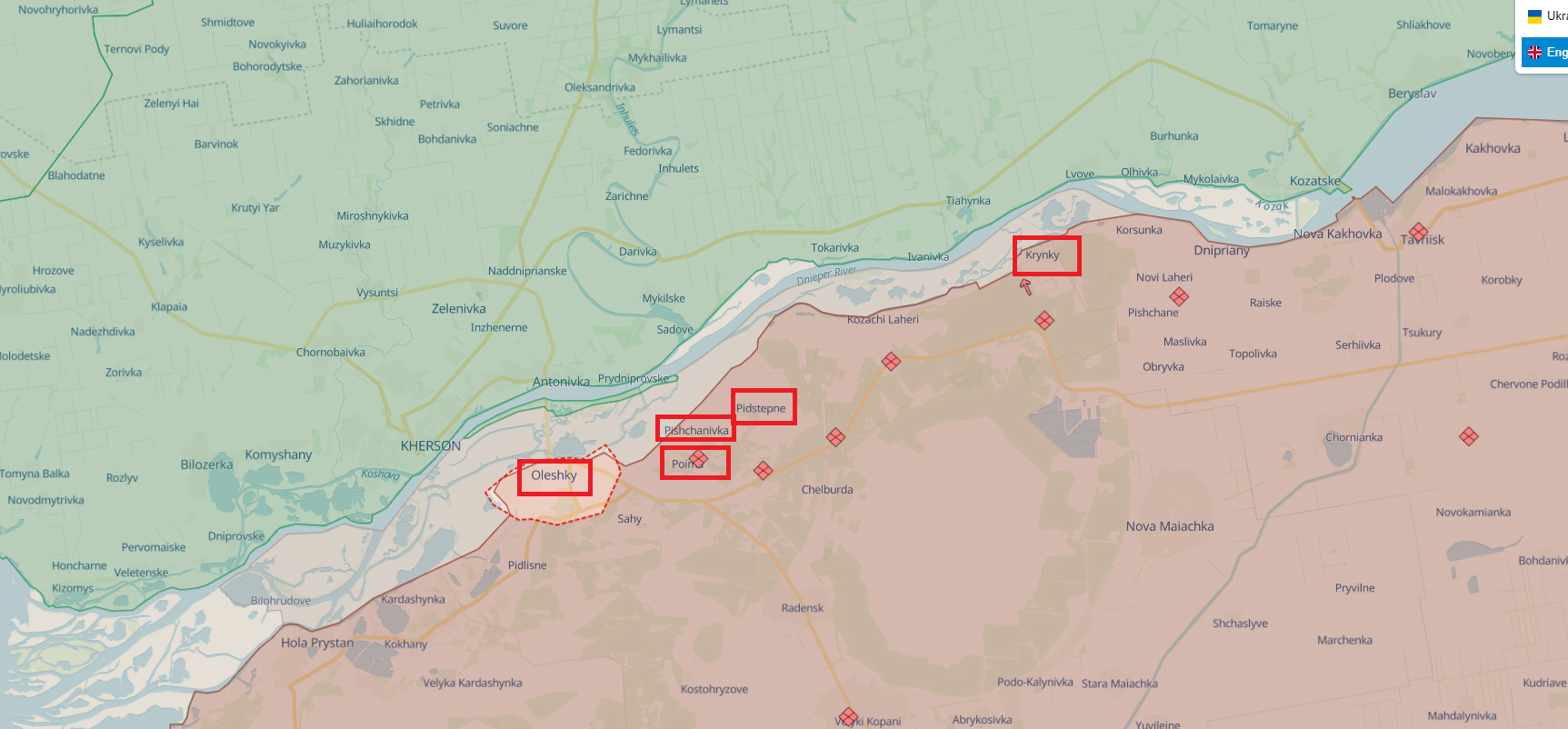To Crimea - 80 km: What's happening on Kherson left bank under continuous control of Ukrainian Armed Forces
 Ukrainian forces expand their foothold on the left bank of the Kherson region (Photo: Getty Images)
Ukrainian forces expand their foothold on the left bank of the Kherson region (Photo: Getty Images)
Ukrainian forces may have established continuous (permanent) control over positions on the left bank of the Kherson region. This pertains to areas near the Antonivka bridges and the road between the occupied Oleshky and Nova Kakhovka.
For more details on what continuous control entails and the implications of the current situation for the occupying forces, read RBC-Ukraine's material.
The preparation of the material involved the use of reports from analysts at the American Institute for the Study of War (ISW) and exclusive comments from military expert Vladyslav Seleznov.
According to the ISW report as of November 9th, Ukrainian forces have established continuous control over positions from the Antonivka railway bridge to the north of the village of Poima, up to the Antonivka road bridge north of Oleshky. Additionally, they may have been able to disrupt the Oleshky-Nova Kakhovka road in at least two locations. This information has not been officially confirmed.
What continuous control means: expanding the foothold and posing a threat to enemy logistics
Vladyslav Seleznov explains that marine infantry units have expanded the foothold on the left bank - along the front, it is approximately 60 km from the Antonivka road bridge to the village of Krynky. Currently, battles are ongoing for further expansion in the Pischanivka, Pidstepne, and Krynyky areas.
The road to Nova Kakhovka is a secondary road running along the Dnipro River line.
"Why is it receiving such attention? It is a lateral route (runs parallel to the front line - Ed.). Of course, the enemy is seriously concerned because it is essential for them to rapidly shift resources to fulfill various tasks. This road is under control in two places, but it is evident that the defense forces are attempting to advance further," he noted in his commentary to RBC-Ukraine.
 Photo: Ukrainian marines expand their foothold on the approaches to populated areas on the left bank of the Kherson region (deepstatemap.live)
Photo: Ukrainian marines expand their foothold on the approaches to populated areas on the left bank of the Kherson region (deepstatemap.live)
He also notes that Russian Z-news agencies claim the presence of supposedly armored vehicles on the left bank, which Ukrainian marines are said to be using.
"How it could have been transported is not exactly known. Of course, armored personnel carriers and infantry fighting vehicles can independently cross the Dnipro; the distance between the banks is about 1000 meters, which is quite a lot, but our forces are capable of overcoming such water obstacles. So, armored vehicles are appearing there," he added.
What is needed to advance on the left bank of the Kherson region?
For the Ukrainian army to advance further, a large quantity of weapons, equipment, and ammunition is required. A massive deployment can be organized through pontoon bridge crossings.
"In fact, Ukraine currently cannot use stationary structures because the enemy destroyed them. All four bridges over the Dnipro in this area are destroyed. These include the Antonivka railway bridge, the Antonivka road bridge, and the bridges near the dam in Nova Kakhovka. The dam itself is no longer there because the Russians blew it up, so pontoon bridge crossings need to be established," says Seleznov.
Specialized equipment is needed for this purpose. However, an equally challenging task is to secure the crossing from enemy aviation and artillery. Currently, this is difficult to achieve due to Russia's overwhelming advantage in the aviation component. A possible solution is to expand the network of air defense systems to keep the enemy as far away from the Dnipro as possible.
How will the situation develop on the left bank?
The situation on the left bank will depend on whether the Ukrainian army has sufficient resources to advance.
"There is no definitive answer; this information is classified. But there is a key point. Ukrainian marines are holding a foothold 60 km along the front, and the enemy is forced to react by redeploying airborne units, including those recently stationed in the Tokmak direction. In doing so, the enemy has reduced its presence on this section of the front," asserts the expert.
Can one speak of tactical success?
Certainly, at this moment, there are tactical successes. It is important to note the details: the distance from the Dnipro to the Crimean crossings, particularly in the Kalanchak and Chaplynka areas, is about 80 km. Throughout the entire period of occupation, the Russians did not establish a powerful network of engineering, fortification, and defensive structures there. Something is being built on the approach to the crossings, but overall, there are almost none in the southern part of the Kherson region.
"They were confident that the Ukrainian army would not be able to cross the Dnipro. However, we see that the situation is changing, and it is a great opportunity for the defense forces. Transforming this opportunity into the liberation of territories can only be done with the necessary resources. The results we achieve will depend on this," noted Seleznov.
What the Russians will do?
If we imagine that the Ukrainian army can advance along the E-97 route towards the Crimean crossings, the grouping of enemy forces in the western part of the southern Kherson region may find itself surrounded. This includes the Biloberizhzhia National Park, Kinburn Spit, and the surrounding areas.
"From there, the enemy is still trying to target Ochakiv and settlements on the opposite bank of the Dnipro-Bug estuary. Accordingly, they will have to retreat from there to avoid being surrounded. Thus, the enemy may find itself in a rather difficult situation. If Ukrainian forces move further, the Russians will have to quickly retreat from Zaliznyi Port, Lazurne, Skadovsk to the occupied Crimea. Whether they will be able to use the main communication routes in time is a debatable question," explained the expert.
However, it is too early to talk about this. The liberation of the southern Kherson region requires significant resources. The opponent has concentrated up to 65,000 people there, which is a considerable number, approximately as many as in the southern part of the Zaporizhzhia region and the Lyman-Kupiansk direction.
"Thus, relying on strength, the enemy is trying to halt the advance of the marines. Moreover, now, along the T2206 route from Oleshky slightly south of Nova Kakhovka, effectively in the direction of Melitopol, they are building defensive lines. In case of the Ukrainian army's advance, they will dig in," added Seleznov.

